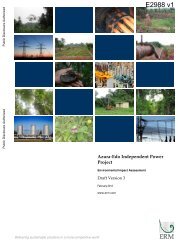Diagnostic Study on Access to Finance for Women.pdf - IFC
Diagnostic Study on Access to Finance for Women.pdf - IFC
Diagnostic Study on Access to Finance for Women.pdf - IFC
You also want an ePaper? Increase the reach of your titles
YUMPU automatically turns print PDFs into web optimized ePapers that Google loves.
NOVEMBER 2006<br />
Foreword<br />
Annex 4 and 5<br />
I<br />
t is my pers<strong>on</strong>al and professi<strong>on</strong>al belief that facilitating equitable and easy access<br />
<strong>to</strong> finance is key <strong>for</strong> us <strong>to</strong> unlock the entrepreneurial potential am<strong>on</strong>gst South African<br />
women. Fortunately, this view was well supported by women all over the country who<br />
actively participated in our c<strong>on</strong>sultati<strong>on</strong> drive as part of developing the draft Nati<strong>on</strong>al<br />
Strategic Framework <strong>on</strong> Gender and <strong>Women</strong>’s Ec<strong>on</strong>omic Empowerment. His<strong>to</strong>rically,<br />
the financial markets have always been gender blind, thus becoming the major obstacle<br />
<strong>for</strong> women <strong>to</strong> start, grow and strengthen their enterprises. As noted in the Financial<br />
Sec<strong>to</strong>r Services Charter, the financial sec<strong>to</strong>r is characterised by low levels of participati<strong>on</strong>,<br />
meaningful ownership, c<strong>on</strong>trol, management, as well as low levels of skilled positi<strong>on</strong>s<br />
occupied by black women.<br />
Part of creating a favourable envir<strong>on</strong>ment <strong>for</strong> growing<br />
women’s entrepreneurship in South Africa, it is required<br />
of us <strong>to</strong> come up with empirical factual research <strong>on</strong> how<br />
the financial markets have been engaging with women<br />
in the new South Africa. We also wanted <strong>to</strong> establish more<br />
facts as <strong>to</strong> how both these financial markets, <strong>to</strong>gether with<br />
our ec<strong>on</strong>omic policies, have brought about the desired<br />
impacts in as far as trans<strong>for</strong>ming our ec<strong>on</strong>omy is c<strong>on</strong>cerned.<br />
Through this study, we now have a clear picture with<br />
Malib<strong>on</strong>gwe!<br />
Ms Elizabeth Thabethe: MP<br />
Deputy Minister of Trade and Industry<br />
answers <strong>on</strong> how and what it is that needs <strong>to</strong> be d<strong>on</strong>e by<br />
the government in partnership with the private sec<strong>to</strong>r <strong>to</strong><br />
be able <strong>to</strong> ensure that women are enabled <strong>to</strong> be fully<br />
represented whilst actively participating in our ec<strong>on</strong>omy.<br />
I trust that all you readers will find it useful and that<br />
you will work <strong>to</strong>gether with us in your own way in making<br />
the South African financial markets more supportive <strong>to</strong><br />
women entrepreneurs. Our ec<strong>on</strong>omy needs both its men<br />
and women <strong>to</strong> grow.<br />
Annex 4<br />
KEY FINANCIAL INDICATORS OF TWO MFIs<br />
KEY FINANCIAL INDICATORS FROM THE SMALL ENTERPRISE FOUNDATION 2003-2006<br />
June 2003 June 2004 June 2005 June 2006 (Projected)<br />
Active Clients 18 812 22 110 27 538 35 446<br />
Portfolio Outstanding R13.5m R19.1m R26.4m R32.2m<br />
Portfolio at Risk > 30 days 1.1% 0.2% 0.2% 0.5%<br />
Repayment Rate 98.5% 98.7% 99.6% 99%<br />
Operati<strong>on</strong>al Self-sufficiency 78% 100% 100% 100%<br />
Financial Self-sufficiency 76% 94% 92% 95%<br />
Loan Loss Rate 1.5% 1.3% .4% 1%<br />
KEY FINANCIAL INDICATORS FROM MARANG FINANCIAL SERVICES 2001-2005<br />
Indica<strong>to</strong>rs March 2001 March 2002 March 2003 March 2004 March 2005<br />
No. of borrowers 5,132 13,153 15,683 21,691 26,244<br />
No. of groups 1,027 2,645 3,293 4,439 5,358<br />
Portfolio outstanding 2,734,965* 7,820,167 9,605,563 15,582,682 20,440,559<br />
Repayment rate 100% 98.03% 97.7% 98% 94%<br />
Portfolio at risk > 30 days 0% 1.18% 1.2% 1.47% 5.01%<br />
Loan loss rate incl. death 0.16% 0.53% 1% 1% 2.2%<br />
Loan loss rate excl. death 0% 0.28% 0.50% 0.41% 1.5%<br />
Operati<strong>on</strong>al Self-sufficiency 9.91% 61.98% 71.93% 87.37% 116.91%<br />
Financial Self-sufficiency 9,91% 58.17% 63.21% 82.72% 112.14%<br />
* All currency is in ZAR<br />
Annex 5<br />
BDS INSTITUTIONS INTERVIEWED<br />
Types of Instituti<strong>on</strong>s<br />
State sp<strong>on</strong>sored<br />
Independent Commercial Providers<br />
Educati<strong>on</strong>al Instituti<strong>on</strong>s<br />
NGOs<br />
Instituti<strong>on</strong>s Interviewed<br />
Red Door – Western Cape – Atlantis branch – provides a generic “<strong>on</strong>e-s<strong>to</strong>p shop”<br />
Thuso Men<strong>to</strong>rship Scheme – a nati<strong>on</strong>al programme of Khula Enterprise <strong>Finance</strong> Limited<br />
– interviewed in Centuri<strong>on</strong> and Midrand<br />
The Innovati<strong>on</strong> Hub – in Pre<strong>to</strong>ria – technology business incuba<strong>to</strong>r<br />
Enablis – predominantly ICT sec<strong>to</strong>r based, offering an integrated model based in Western<br />
Cape and Gauteng<br />
Business Skills South Africa – based in Pre<strong>to</strong>ria – SMME training programme<br />
Unilever Foundati<strong>on</strong><br />
UCT Business School – Cape Town – integrated model which offers pre- and postloans<br />
support<br />
Nati<strong>on</strong>s Trust – Gauteng – pre- and post-loan support <strong>to</strong> micro and very small enterprises<br />
<strong>to</strong> support their loan programme services <strong>for</strong> youth Micro MBA – based in Cape Town but<br />
with a nati<strong>on</strong>al footprint<br />
ANNEX 4 AND 5 89
















